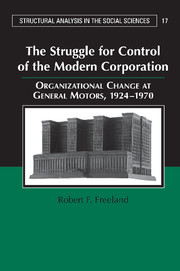 The Struggle for Control of the Modern Corporation
The Struggle for Control of the Modern Corporation Book contents
- Frontmatter
- Contents
- List of Figures and Tables
- Acknowledgments
- 1 The Modern Corporation and the Problem of Order
- 2 Creating Corporate Order: Conflicting Versions of Decentralization at GM, 1921–1933
- 3 Administrative Centralization of the M-form, 1934–1941
- 4 Participative Decentralization Redefined: Mobilizing for War Production, 1941–1945
- 5 The Split between Finance and Operations: Postwar Problems and Organization Structure, 1945–1948
- 6 Consent as an Organizational Weapon: Coalition Politics and the Destruction of Cooperation, 1948–1958
- 7 Consent Destroyed: The Decline and Fall of General Motors, 1958–1980
- 8 Conclusion
- Appendix: General Motors' Financial Performance, 1921–1987
- References
- Index
7 - Consent Destroyed: The Decline and Fall of General Motors, 1958–1980
Published online by Cambridge University Press: 05 August 2011
- Frontmatter
- Contents
- List of Figures and Tables
- Acknowledgments
- 1 The Modern Corporation and the Problem of Order
- 2 Creating Corporate Order: Conflicting Versions of Decentralization at GM, 1921–1933
- 3 Administrative Centralization of the M-form, 1934–1941
- 4 Participative Decentralization Redefined: Mobilizing for War Production, 1941–1945
- 5 The Split between Finance and Operations: Postwar Problems and Organization Structure, 1945–1948
- 6 Consent as an Organizational Weapon: Coalition Politics and the Destruction of Cooperation, 1948–1958
- 7 Consent Destroyed: The Decline and Fall of General Motors, 1958–1980
- 8 Conclusion
- Appendix: General Motors' Financial Performance, 1921–1987
- References
- Index
Summary
The textbook M-form led not to rejuvenation and success, but to decline and eventual failure. Ironically, Du Pont representatives would have little opportunity to oversee the organization that they helped put into place. In November 1959, little more than a year after the reorganization, Donaldson Brown, Walter S. Carpenter, Jr., Lammot du Pont Copeland, Emile F. du Pont, and Henry B. du Pont resigned from GM's board as part of the final judgment in the U.S. antitrust suit. With the sale of Du Pont's holdings of GM stock completed, ownership of the corporation was atomized. Financial control at GM would henceforth be carried out almost entirely by GM's own finance staff, with minimal oversight by shareholders. On the operating side of the organization, the new structure disrupted divisional consent rather than producing it. Because the Administration Committee no longer had any formal authority in the planning process, division managers were unable to participate in strategic planning, leaving them subject to legislation without representation. This led to what Fligstein has termed a finance conception of control: with operating men cut out of the planning and resource allocation process, top executives paid little attention to advice offered from the divisions. Instead, the decision-making process was dominated by men with little or no operating experience, and, just as Sloan had feared, operating issues were increasingly subordinated to financial criteria. Over time, even the Executive Committee became almost completely dominated by financial men, as group executives on that committee were replaced by financial men who were even further removed from divisional information and concerns.
- Type
- Chapter
- Information
- The Struggle for Control of the Modern CorporationOrganizational Change at General Motors, 1924–1970, pp. 271 - 294Publisher: Cambridge University PressPrint publication year: 2000
